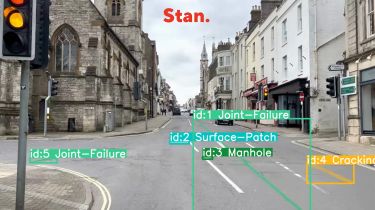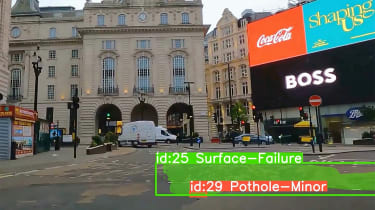New phone app reports potholes to the council as you drive
The app reports damaged roads to councils automatically from a smartphone mounted in your car’s windscreen.
A revolutionary new ‘crowd-sourcing’ app allows drivers to automatically report the condition of every road they drive on to the responsible council or authority, using their own smartphone mounted in the windscreen.
The app is called Stan, and is free for drivers to download and use - with no sign-up or personal data collected or stored. Drivers can become ‘citizen surveyors’ for their local council by using their smartphone camera to record the state of the roads during any car journey. Every council will be provided with a portal and log-in, where data from reports made via the app will be continuously shared.
‘Video’ and individual images recorded via the app will be screened using an advanced Artificial Intelligence (AI) ‘neural network’ that can accurately recognise and flag-up a multitude of issues. These range from small cracks and crumbling surfaces, to road edge failures, potholes of all sizes, areas of water pooling, faded road markings, and even dirty or obstructed road traffic signs. In all, developer Metricell says, the AI has been trained to recognise and record 45 different surface or infrastructure conditions where repair or maintenance is required. Additionally, drivers will be able to zoom into their local area on a nationwide ‘road health’ map at stantheapp.com, giving them new insights into the state of their local roads on a constantly updated basis, as well as being able to compare the health of their roads to those maintained by neighbouring councils.
The company behind the new app believes its innovation has the potential to transform the way road maintenance is managed by local authorities. Metricell sales director Mike Mockford told us some councils currently undertake surveys using expensive rented scanning machines they may have access to for only a week every year, while others rely heavily on public reporting, often using a long-winded form on a council website.
“It’s a long process and there’s lots of duplication,” Mockford claims. “We’re using artificial intelligence to cleanse our crowd-sourced data, and with our technology we think drivers could potentially survey an entire county every two weeks, so councils can make a much better maintenance plan.
“The big question is whether we can get enough Stans,” he says. “Are there enough people who are frustrated enough with the state of the roads to want to do something about it? We think there are, but we’ll see how it goes!”
Whether councils are happy to embrace the implications of Stan remains to be seen, and Mockford acknowledges that traditional working practices may be hard to overcome. He says initial feedback suggests some councils may not want Stan telling them how many potholes they have, because once they know about individual road faults they become liable for fixing them.
“Our job is to convince them that yes, there will be a lot within the first six months, but this way you get to assess your entire network, and not just five per cent of it. We can also help with data cleansing and prioritising maintenance on major roads as opposed to big potholes where no one drives.”
Cllr Darren Rodwell, transport spokesperson for the Local Government Association, said: “Councils already invite road users to report highways defects and any new ways that support this and make this easier is helpful.
“Whilst this information will help councils in their planning of road repairs, limited resources will mean councils will need to continue to prioritise according to local circumstances, and to focus on preventive measures where they can.
“Longer-term, the Government should award council Highways Departments with five yearly funding allocations to give more certainty, bringing councils on a par with National Highways so they can develop resurfacing programmes and other highways improvements, tackling the scourge of potholes.”
How does Stan work? We review it…
Downloading the app is fast and free, and it’s immediately ready to go with no need to sign-in or create an account. Two options are offered on the app home screen; photo mode allows you to report individual potholes using a single picture, while drive mode records the road ahead as you go.
If you choose drive mode, you’re initially shown a video-style image of the view ahead, so you can adjust your camera angle. Once driving, however, the screen goes black with a red ‘recording’ dot to save phone battery - and reduce the opportunity for distraction. Drive mode will work with a passenger holding your phone, but serious users will need to invest in a sucker-type windscreen mount to get the best from Stan.
Whether using photo or drive mode, simply touching the on-screen finish button generates a report that you can optionally name or add notes to, before submitting.
There’s a slightly confusing ‘Reports Submitted’ bar that looks like an ‘upload in progress’ indicator but isn’t, so we weren’t immediately sure if uploads had been completed - but in fact they processed quickly. You can see a Google-style map of the drives you’ve submitted via the app, but disappointingly you don’t get access to detailed AI-screened data from your journeys on the app or via the website.
If you’re worried about the data cost implications of recording and submitting a report of a three-hour drive, you’ll be pleased to know that Stan won’t connect via the mobile network - it waits until you have a wifi connection before uploading. The data requirement is reduced too, by Stan taking individual pictures every half-second in drive mode, rather than recording with full video.
As early adopters, I got to test Stan over roads we knew well, and it was gratifying to check out the website an hour later to see our drives had resulted in some awful local tarmac showing up red on the road health map - while very little showed green, which indicates a road in good condition.
As the map fills up with reports from other Stans, you’ll have to take it on trust that your efforts are making a difference. But we’ll definitely be using Stan again, and hopefully so will thousands of others, highlighting very publicly just how neglected our national road network has become.
Do you think Stan will make a difference to the state of the UK's roads? Have your say in the comments...
Find a car with the experts







